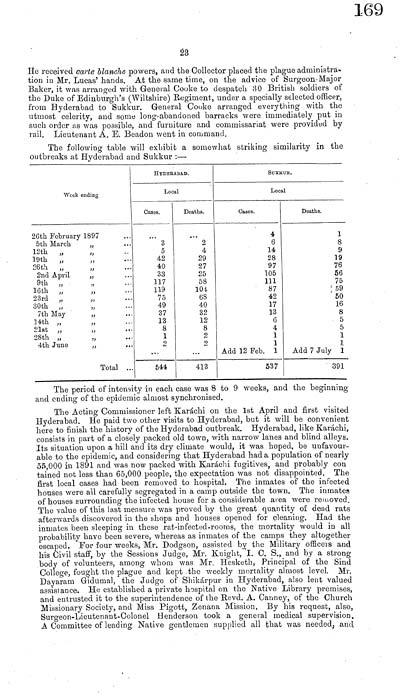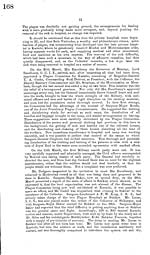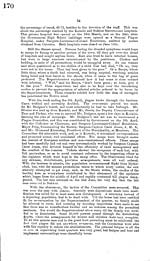Medicine - Disease > Account of plague administration in the Bombay Presidency from September 1896 till May 1897
(183) Page 169
Download files
Individual page:
Thumbnail gallery: Grid view | List view

23
He received carte blanche powers, and the Collector placed the plague administra-
tion in Mr. Lucas' hands. At the same time, on the advice of Surgeon-Major
Baker, it was arranged with General Cooke to despatch 30 British soldiers of
the Duke of Edinburgh's (Wiltshire) Regiment, under a specially selected officer,
from Hyderabad to Sukkur. General Cooke arranged everything with the
utmost celerity, and some long-abandoned barracks were immediately put in
such order as was possible, and furniture and commissariat were provided by
rail. Lieutenant A. E. Beadon went in command.
The following table will exhibit a somewhat striking similarity in the
outbreaks at Hyderabad and Sukkur :-
HYDERABAD.
SUKKUR.
Week ending
Local
Local
Cases.
Deaths.
Cases.
Deaths.
26th February 1897
4
1
5th March "
3
2
6
8
12th " "
5
4
14
9
19th " "
42
29
28
19
26th " "
40
27
97
76
2nd April "
33
25
105
56
9th " "
117
58
111
75
16th " "
119
104
87
59
23rd " "
75
68
42
50
30th " "
49
40
17
16
7th May "
37
32
13
8
14th " "
13
12
6
5
21st " "
8
8
4
5
28th " "
1
2
1
1
4th June "
2
2
1
1
Add 12 Feb. 1
Add 7 July 1
Total
544
413
537
391
The period of intensity in each case was 8 to 9 weeks, and the beginning
and ending of the epidemic almost synchronised.
The Acting Commissioner left Karchi on the 1st April and first visited
Hyderabad. He paid two other visits to Hyderabad, but it will be convenient
here to finish the history of the Hyderabad outbreak. Hyderabad, like Karchi,
consists in part of a closely packed old town, with narrow lanes and blind alleys.
Its situation upon a hill and its dry climate would, it was hoped, be unfavour-
able to the epidemic, and considering that Hyderabad had a population of nearly
55,000 in 1891 and was now packed with Karchi fugitives, and probably con
tained not less than 65,000 people, the expectation was not disappointed. The
first local cases had been removed to hospital. The inmates of the infected
houses were all carefully segregated in a camp outside the town. The inmates
of houses surrounding the infected house for a considerable area were removed. The value of this last measure was proved by the great quantity of dead rats
afterwards discovered in the shops and houses opened for cleaning. Had the
inmates been sleeping in these rat-infected-rooms, the mortality would in all
probability have been severe, whereas as inmates of the camps they altogether
escaped. For four weeks, Mr. Dodgson, assisted by the Military officers and
his Civil staff, by the Sessions Judge, Mr. Knight, I. C. S., and by a strong
body of volunteers, among whom was Mr. Hesketh, Principal of the Sind
College, fought the plague and kept the weekly mortality almost level. Mr.
Dayaram Gidumal, the Judge of Shikrpur in Hyderabad, also lent valued
assistance. He established a private hospital on the Native Library premises,
and entrusted it to the superintendence of the Revd. A. Canney, of the Church
Missionary Society, and Miss Pigott, Zenana Mission. By his request, also,
Surgeon-Lieutenant-Colonel Henderson took a general medical supervision.
A Committee of leading Native gentlemen supplied all that was needed, and
He received carte blanche powers, and the Collector placed the plague administra-
tion in Mr. Lucas' hands. At the same time, on the advice of Surgeon-Major
Baker, it was arranged with General Cooke to despatch 30 British soldiers of
the Duke of Edinburgh's (Wiltshire) Regiment, under a specially selected officer,
from Hyderabad to Sukkur. General Cooke arranged everything with the
utmost celerity, and some long-abandoned barracks were immediately put in
such order as was possible, and furniture and commissariat were provided by
rail. Lieutenant A. E. Beadon went in command.
The following table will exhibit a somewhat striking similarity in the
outbreaks at Hyderabad and Sukkur :-
HYDERABAD.
SUKKUR.
Week ending
Local
Local
Cases.
Deaths.
Cases.
Deaths.
26th February 1897
4
1
5th March "
3
2
6
8
12th " "
5
4
14
9
19th " "
42
29
28
19
26th " "
40
27
97
76
2nd April "
33
25
105
56
9th " "
117
58
111
75
16th " "
119
104
87
59
23rd " "
75
68
42
50
30th " "
49
40
17
16
7th May "
37
32
13
8
14th " "
13
12
6
5
21st " "
8
8
4
5
28th " "
1
2
1
1
4th June "
2
2
1
1
Add 12 Feb. 1
Add 7 July 1
Total
544
413
537
391
The period of intensity in each case was 8 to 9 weeks, and the beginning
and ending of the epidemic almost synchronised.
The Acting Commissioner left Karchi on the 1st April and first visited
Hyderabad. He paid two other visits to Hyderabad, but it will be convenient
here to finish the history of the Hyderabad outbreak. Hyderabad, like Karchi,
consists in part of a closely packed old town, with narrow lanes and blind alleys.
Its situation upon a hill and its dry climate would, it was hoped, be unfavour-
able to the epidemic, and considering that Hyderabad had a population of nearly
55,000 in 1891 and was now packed with Karchi fugitives, and probably con
tained not less than 65,000 people, the expectation was not disappointed. The
first local cases had been removed to hospital. The inmates of the infected
houses were all carefully segregated in a camp outside the town. The inmates
of houses surrounding the infected house for a considerable area were removed. The value of this last measure was proved by the great quantity of dead rats
afterwards discovered in the shops and houses opened for cleaning. Had the
inmates been sleeping in these rat-infected-rooms, the mortality would in all
probability have been severe, whereas as inmates of the camps they altogether
escaped. For four weeks, Mr. Dodgson, assisted by the Military officers and
his Civil staff, by the Sessions Judge, Mr. Knight, I. C. S., and by a strong
body of volunteers, among whom was Mr. Hesketh, Principal of the Sind
College, fought the plague and kept the weekly mortality almost level. Mr.
Dayaram Gidumal, the Judge of Shikrpur in Hyderabad, also lent valued
assistance. He established a private hospital on the Native Library premises,
and entrusted it to the superintendence of the Revd. A. Canney, of the Church
Missionary Society, and Miss Pigott, Zenana Mission. By his request, also,
Surgeon-Lieutenant-Colonel Henderson took a general medical supervision.
A Committee of leading Native gentlemen supplied all that was needed, and
Set display mode to: Large image | Zoom image | Transcription
Images and transcriptions on this page, including medium image downloads, may be used under the Creative Commons Attribution 4.0 International Licence unless otherwise stated. ![]()
| India Papers > Medicine - Disease > Account of plague administration in the Bombay Presidency from September 1896 till May 1897 > (183) Page 169 |
|---|
| Permanent URL | https://digital.nls.uk/74517376 |
|---|




